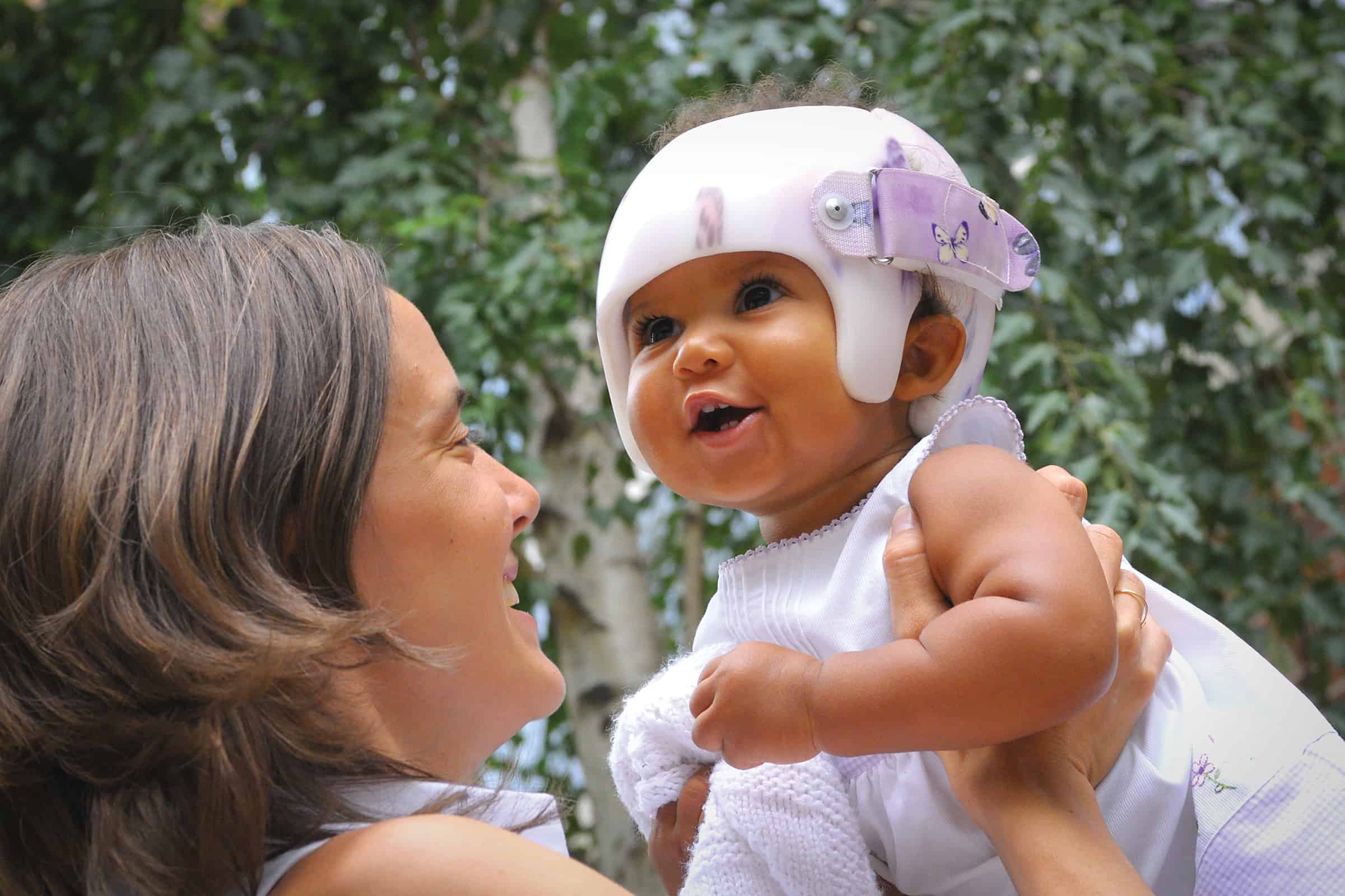Parents support effectiveness of plagiocephaly orthoses
Researchers investigated the clinical effectiveness of cranial molding orthotic treatment for infants with plagiocephaly and the parents’ perspectives of the treatment.

STARband® baby and mother. Orthomerica photo
by The O&P EDGE, November 13, 2018
The research team found that a high percentage of parents felt that the treatment met their initial goals in spite of any adverse events. Parents perceived that cranial molding orthoses were more effective when their children had severe initial skull asymmetry and when the orthoses were applied earlier in infancy.
A retrospective medical chart review was conducted for 82 infants treated for plagiocephaly with cranial molding orthoses at a clinic in Seoul, Korea, from April 2012 to July 2016. Infants who were clinically diagnosed with positional plagiocephaly and had a cranial vault asymmetry index (CVAI) of more than 3.5 percent were included. Pre- and post-treatment CVAI was obtained with a Vorum 3D laser scanner. The infants’ mean age at the initiation of cranial molding orthotic therapy was 24.3 weeks (± 8.4 weeks).
Parents’ perceptions of good outcome (satisfaction) were evaluated with the Goal Attainment Scale (GAS) to assess how much the parent felt that his or her initial goal for correcting the child’s skull asymmetry was achieved after the treatment. The GAS scoring metric ranged from 2 (much greater than expected outcome) to -2 (much less than expected outcome).
There were 53 infants (65 percent) who had adverse events with the orthoses during the study. Heat rash was the most common adverse effect found in 29 cases (35.4 percent). Orthosis compliance was 90.2 percent (74 of 82 infants). The GAS ratings were converted to a GAS T-score with a mean of 50 and standard deviation of 10. The mean GAS T-score was 51.9 ± 10.2. A GAS T-score of 0 or more was identified for 71.6 percent of parents. The GAS T-score was significantly related to the child’s age, the initial CVAI, and the difference in CVAI during the treatment, according to the study’s authors.
The open-access study was published October 31 in the Annals of Rehabilitation Medicine.
Source The O&P EDGE
| References |
Parents’ Perspectives and Clinical Effectiveness of Cranial-Molding Orthoses in Infants With Plagiocephaly, Lee HS, Kim SJ, Kwon JY. Ann Rehabil Med. 2018 Oct;42(5):737-747. doi: 10.5535/arm.2018.42.5.737. Epub 2018 Oct 31. Full text, PDF
| Further reading |
Natural-Course Evaluation of Infants with Positional Severe Plagiocephaly Using a Three-Dimensional Scanner in Japan: Comparison with Those Who Received Cranial Helmet Therapy, Noto T, Nagano N, Kato R, Hashimoto S, Saito K, Miyabayashi H, Sasano M, Sumi K, Yoshino A, Morioka I. J Clin Med. 2021 Aug 11;10(16):3531. doi: 10.3390/jcm10163531. Full text, PDF
Applicative Factors of Helmet Molding Therapy in Late-diagnosed Positional Plagiocephaly, Kim MJ, Kang MK, Deslivia MF, Kim YO, Choi JW. J Korean Med Sci. 2020 Sep 14;35(36):e295. doi: 10.3346/jkms.2020.35.e295. Full text, PDF
Assessment of facial and cranial symmetry in infants with deformational plagiocephaly undergoing molding helmet therapy, Visse HS, Meyer U, Runte C, Maas H, Dirksen D. J Craniomaxillofac Surg. 2020 Jun;48(6):548-554. doi: 10.1016/j.jcms.2020.04.003. Epub 2020 Apr 21.
Relationship between facial asymmetry and positional plagiocephaly analyzed by three-dimensional computed tomography, Sasaki J, Hasegawa S, Yamamoto S, Watanabe S, Miyachi H, Nagao T. J Craniomaxillofac Surg. 2020 Mar;48(3):193-198. doi: 10.1016/j.jcms.2019.12.011. Epub 2019 Dec 13.
A 3D Follow-Up Study of Cranial Asymmetry from Early Infancy to Toddler Age after Preterm versus Term Birth, Launonen AM, Aarnivala H, Kyteas P, Vuollo V, Heikkinen T, Kau CH, Pirttiniemi P, Harila V, Valkama AM. J Clin Med. 2019 Oct 11;8(10):1665. doi: 10.3390/jcm8101665. Full text, PDF
Head orthosis therapy in positional plagiocephaly: longitudinal 3D-investigation of long-term outcomes, compared with untreated infants and with a control group, Kunz F, Schweitzer T, Große S, Waßmuth N, Stellzig-Eisenhauer A, Böhm H, Meyer-Marcotty P, Linz C. Eur J Orthod. 2019 Jan 23;41(1):29-37. doi: 10.1093/ejo/cjy012. Full text
Therapy effects of head orthoses in positional plagiocephaly, Dörhage KWW, Beck-Broichsitter BE, von Grabe V, Sonntag A, Becker ST, Wiltfang J. J Craniomaxillofac Surg. 2016 Oct;44(10):1508-1514. doi: 10.1016/j.jcms.2016.06.035. Epub 2016 Jul 7.
Orthotic (helmet) therapy in the treatment of plagiocephaly, Goh JL, Bauer DF, Durham SR, Stotland MA. Neurosurg Focus. 2013 Oct;35(4):E2. doi: 10.3171/2013.7.FOCUS13260. Full text
Also see
What is Deformational Plagiocephaly? (Flat Head Syndrome) Orthomerica
